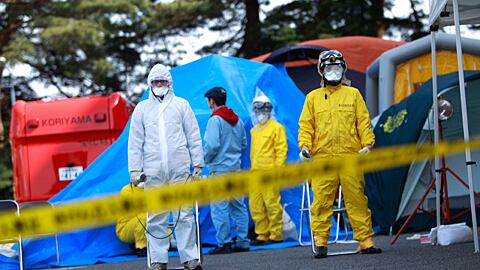Experts are calling the Japanese nuclear crisis the worst since Chernobyl after a third explosion and a fire at the Fukushima Daiichi nuclear plant Monday. Radiation levels near one reactor were 400 times the normal amount a human should experience in a year. Japan’s government has told people living within 20 miles of the plant to stay indoors, and the Tokyo metropolitan government has said it has detected radiation levels 20 times above normal over the city. So far, winds have blown most of the radiation out to sea.
As the world watches the nuclear disaster unfold in Japan, Rory Kennedy and Keven McAlester remind us that America’s plants are even more vulnerable than the ones in Japan. Plus, full coverage of the quake and tsunami.
Like the rest of the world, we watched with great sadness and distress as images of the earthquake and tsunami in Japan began to emerge. No matter how powerful or safe we all believe modern society has made us, human progress remains constantly humbled by the profound forces of nature.

Our heartbreak soon became horror as the nuclear emergency developed, and the news continues to get worse. At the time of this writing, rods in at least three separate reactors at the Fukushima Daiichi nuclear-power plant have partially melted down, contaminating air and causing mass evacuations. Even as the disaster is still unfolding, it's a worst-case scenario that Americans very much need to consider.
Rory recently examined the potential effects of an accident or terrorist attack at the Indian Point nuclear-power plant in a film called Indian Point: Imagining the Unimaginable. Indian Point sits 24 miles north of New York City. An incident there would mean evacuating or exposing to deadly radiation a minimum of 10 million people. The plant causing the Japanese disaster sits 80 miles from the earthquake's epicenter; in 2008 Columbia University's Earth Institute discovered that Indian Point sits less than two miles from two separate faults—one of which, the Ramapo Fault Line, is the longest and most potentially devastating seismic zone in the Eastern U.S.
Such earthquake danger is not unique to Indian Point. According to the U.S. Geological Survey, 39 of our 50 states have moderate to high seismic risks, and of our 65 nuclear-power facilities (housing a total of 104 reactors), almost half sit perilously close to active fault lines—including two near California's San Andreas Fault and more than a dozen in the Midwest within damage range of a 6.8 earthquake along the New Madrid Fault, which in 1811 and 1812 caused four separate catastrophic quakes with estimated magnitudes of around 8. And now we can expect any potential earthquake damage to be amplified by age.
New-plant constructions stopped in 1977, and our most recent nuclear incident, in Vermont last year, occurred when radiation leaked simply because of decaying pipes.
The devastating irony is that the Japanese tragedy occurs at a time when nuclear power has successfully rebranded itself, as so many controversial issues have a way of doing. Beginning in the first year of the Bush administration, the nuclear-power industry undertook a widespread campaign to recast nuclear power as an environmentally friendly source of "clean energy." The argument: a nuclear-power plant doesn't emit any waste gases when it creates power, much less those that contribute to global warming, so an operating nuclear facility is actually far safer and cleaner than one powered by coal, oil, or natural gas.
The devastating irony is that the Japanese tragedy occurs at a time when nuclear power has successfully rebranded itself, as so many controversial issues have a way of doing.
This argument succeeds on myopia alone. The two greatest dangers associated with nuclear power have nothing to do with operating emissions. The first is nuclear waste. A typical plant produces 27 tons of high-level radioactive waste each year, and in the U.S. there exists no permanent plan for its disposal. Literally none. Spent-fuel rods, which remain lethally hot for months, are mostly placed in indoor cooling pools. Such storage was originally intended to last a few months, but absent a permanent solution, it's become the default long-term option.
The water in these pools requires cooling and circulation; if the pool cracks and water leaks, or if the cooling stops and the water evaporates, a de facto meltdown begins—except with roughly 10 times the radioactivity of a single reactor, in a building with far less containment security. The potential damage, in turn, also multiplies. An earthquake need cause only one rogue crack or lengthy power failure for this unthinkable scenario to develop, and as the sheer volume of waste becomes staggering, the risk only grows.
The second danger is a reactor meltdown, and those have so far occurred only when plants are technically not operating. The Chernobyl disaster happened during a maintenance shutdown when the reactor was actually off—engineers were testing a power source that would activate in case of emergency, and the test caused two explosive power surges. The scope of that disaster was well documented. Today, as testimony to the true "cleanliness" of nuclear energy, we have 220,000 members of the Chernobyl cleanup crew who subsequently died or became disabled, according to their union; we have a reported 2.4 million Ukrainians with health problems related to the incident; we have an estimated 10,000 children born with serious defects, half of whom did not survive birth; we have 369 farmers in the distant United Kingdom who to this day cannot use their contaminated land; we have 350,000 people subjected to forced relocation; and we have 50 people who died as a direct result of the explosion. The argument that radiation is "clean energy" stands as an insult to all these victims and the thousands of undocumented ones.
And also to those now affected by the unfolding crisis in Japan.
We're all being told that plant design and safety have evolved to the point where reactors are now effectively accident-proof. The same was said of the Japanese plant currently melting down. And indeed, its safety mechanisms worked perfectly during the earthquake itself. But then the tsunami knocked out the backup generators. Then the third and final backup, batteries, lasted only eight hours. Then immediate help was hampered by an earthquake-stranded nation. The situation grew from concern to disaster in a matter of hours. Now experts say even if a total meltdown occurs, underground containment vessels will prevent further leakage; yet we await any evidence beyond hope that the vessels were not themselves damaged in critical ways.
It's exactly this kind of multiple-failure scenario that safety experts continually fail to account for, mostly because it's impossible to do so. As recent tragedies caused by hurricanes, tsunamis, and earthquakes have proved, no amount of planning and preparation can fully anticipate the sudden brutality and random course of a natural disaster. Any claims otherwise speak not to deeper understanding but to baser motives. In truth, the lone "clean energy" solution is eliminating nuclear plants altogether.
Especially in an age when terrorism must be added to the list of serious safety threats.
Former president Jimmy Carter—whom we quote here not for partisan reasons, but because he has the distinction of having served as a naval nuclear engineer who participated in an accident cleanup in 1952—has spoken eloquently about the serious problems we must address:
"Our decisions about energy [policy] will test the character of the American people and the ability of the president and the Congress to govern," Carter said. "We will feel mounting pressure to plunder the environment. We will have a crash program to build more nuclear plants, strip-mine and burn more coal, and drill more offshore,” he later continued. “Down that road lies a mistaken idea of freedom, the right to grasp for ourselves some advantage over others ... It is a certain route to failure."
On the other side of the aisle, Republican Senate leader Mitch McConnell preaches caution and respect. "I don't think that right after a major environmental catastrophe is a very good time to be making American domestic policy," he told Fox News on Sunday. We fully agree. A better time would have been when Carter actually gave that speech.
In 1977.
Thirty-four years later, as the world prays for an end to Japan's growing nuclear disaster, it's become clear that President Carter's speech failed to foresee the greatest tragedy of all: that nobody would listen.







